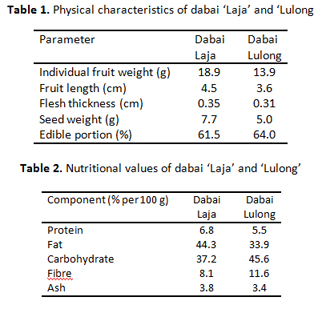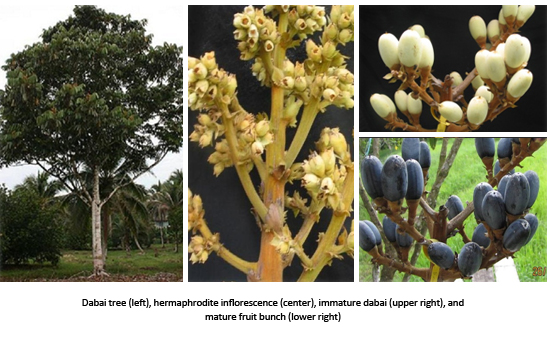Dabai (Canarium odontophyllum Miq.) is an indigenous fruit from the Burseracea family enjoyed in the communities of Sarawak (Borneo), Malaysia with the potential for commercial production. The fruit is sought after for its delicious creamy taste and pleasant aroma and is rich in protein, fat, and minerals.
Despite being a local favorite, dabai cultivation is few and far in between. The Department of Agriculture (DOA), Sarawak, Malaysia partnered with and nursery operators and growers to improve the crop. Superior clonal planting materials from Laja and Lulong were provided for the production and establishment of dabai orchards.
To address high perishability of Dabai, DOA developed a freezing technique to stock high volumes of fruit during the peak season and marketed during off-season. Value-added products have also been developed and have been extended to entrepreneurs.
Several small-scale enterprises have emerged and became front-runners in developing dabai-based products. Local commercialization of the fruit is expected to increase in the near future.
Plant and Fruit Description
 The dabai tree is resiniferous, 8-25 meters tall with a girth of 15-60 cm. The trunk is straight with erect, semi-erect, or horizontal branches. Leaves are odd-pinate with 7-17 leaflets, distinctly acuminate at apex, and are hairy below and on the midrib above.
The dabai tree is resiniferous, 8-25 meters tall with a girth of 15-60 cm. The trunk is straight with erect, semi-erect, or horizontal branches. Leaves are odd-pinate with 7-17 leaflets, distinctly acuminate at apex, and are hairy below and on the midrib above.
The fruit is ovoid to ellipsoid in shape with a slightly triangular in cross-section. The skin is dark purple covering a light yellow flesh. The seed is covered by a hard shell and can be eaten as a nut. It is a rich source of protein, fat, carbohydrates, sodium, calcium, iron, and antioxidants.
To prepare for eating, dabai is steeped in warm water (about 60°C) for 10-15 minutes. This softens the flesh, giving it a smooth avocado-like texture. Dabao can be seasoned with salt, sugar, or soy sauce to enhance the taste.
Dabai is relatively free from pests and diseases, which scientists attribute to its geographical isolation. Therefore, it can easily be produced and marketed as an organic product that commands a higher premium.
Production
The main production areas are mostly concentrated in the central region of Sarawak. Dabai mostly planted by smallholders in mixed orchards that are scattered in villages throughout the state. With the availability of superior clones and improved production technology, larger orchards are slowly emerging. As of 2008, about 13,012 trees were of good quality and were producing 650.6 tons per season. Prices vary depending on the season, quality, and demand, usually from USD 4.00-9.00/kg. During bumper season, the price of dabai can drop to USD 1.50/kg.
 DOA recommends Laja and Lulong clones because they they grow vigorously and begin to bear fruit five years after planting. The initial yield is about 10 kg per tree, and increases up to 80-100 kg per tree after 10 years. Both clones also have excellent eating quality: the bright yellow flesh is delightfully creamy with a slightly sour tinge.
DOA recommends Laja and Lulong clones because they they grow vigorously and begin to bear fruit five years after planting. The initial yield is about 10 kg per tree, and increases up to 80-100 kg per tree after 10 years. Both clones also have excellent eating quality: the bright yellow flesh is delightfully creamy with a slightly sour tinge.
Private nursery operators also identified potential dabai varieties such as Song, Kapit, Intermediate, Egg Yolk, Tarat, Red Dabai, and Pulau Keladi. Fruit evaluation and tree characterization are ongoing to determine the quality of these.
Like most backyard crops, Dabai is widely propagated from seeds. This, however, is not recommended as the saplings may result to trees with variable traits. For large scale propagation, asexual propagation is recommended.
Three commercial nursery operators have engaged with DOA and are promoted as the main producers of planting materials. This effort generated more income for producers and provided high quality planting materials to the masses.
For commercial production, DOA determined that five clusters of 200 trees are enough to supply fruit for product development, promotion, and marketing to new markets. Hence, nucleus dabai growers, consisting of 24 smallholders, were identified and provided with planting materials.
Nutritional composition
Considerable research has been conducted nutritional properties of dabai fruit, kernel, and oil.
Flesh
The pulp makes up about 54-60% of the fruit by weight and contains 41.3% of moisture. When fresh, 100g of the pulp contains: 3.8g protein, 26.2g fat, 4.3g crude fiber, 2.3g ash, 22.1g carbohydrates, and 339 kcal of energy.
While the pulp is usually eaten fresh, it can also be used in cakes, cookies, sandwiches, and pizza. Other dabai products developed by DOA include dabai paste, pitted dabai, dabai crackers, dabai tarts, and dabai cakes.
Kernel
The seed can be eaten as a nut: raw, roasted, sugar-coated, or ingredients in cakes, tarts, and cookies. The kernel, which is 35-40% of fruit weight, contains 27.05% moisture, 10.75 g protein, 26.20 g fat, 47.24 g carbohydrate, 3.35 g ash, 15.80 g crude fiber and 499.36 kcal of energy.
The pulp oil of dabai has 43.42% saturated fatty acid, 42.53% monounsaturated fatty acid, and 14.05% polyunsaturated fatty acid. When compared to palm oil, both have 40% saturated and monounsaturated fatty acids and 12-13% polyunsaturated fatty acids.
It has been suggested that the oil possesses a comparable nutrient content as the palm olein, which is used worldwide for cooking. At 171-181mg KOH/g, the high saponification value of dabai pulp and kernel oils, means it can be used in the production of soap and shampoo.
Antioxidant properties
Different parts of the fruit have been tested for antioxidant properties. It was observed that the skin has the highest antioxidant activity at 89.31%. Respectable levels of phenolic compounds such as cathechin, epigallocatechin gallate, and epicathechin were found in the fruit.
 Commercial enterprises and local market
Commercial enterprises and local market
Dabai fruits and its products are primarily sold in domestic markets. With the nutritional advantages of dabai, the potential exists to develop it as a superfruit for wider domestic and regional markets.
Most small-scale enterprises cater to niche markets that often prefer fresh dabai. This risk-averse strategy leads to slow development and expansion of value-addition through processing.
Among the enterprises that DOA collaborated with is Mariam Cakes, which developed and improved dabai cake products such as a cakes, tarts, rolls, and cookies. Meanwhile, Borneo To The World Sdn. Bhd., manufactured of premium hand-crafted soaps and body wash.
A favorable environment is needed to encourage the private sector to invest in dabai production or processing. Hopefully, the private sector will eventually lead in the commercialization of dabai, based on the research, development, and extension activities.
__________________
This article is adapted from a presentation by Pearlycia Brooke, Department of Agriculture Sarawak, Malaysia, at the International Symposium on Superfruits: Myth or Truth, Vietnam, 1-3 July 2013.
All photos are from the powerpoint presentation.



Dabai is also found in Sabah , a lot in the Sipitang areas and Kinabatangan region where it is the favourite fruit of the emerald imperial pigeon locally called praguam. Due to heavy felling of the jungle it has disappeared in Kinabatangan region. Sabahans learned to eat the fruit from their Sarawakians only recently. July to September are the months when dabai fruits ripen. The Sabah Hakka Chinese call it San Lam ie jungle olive. The Sabah variety seems somewhat larger in size.
Good evening, I am from Kuala Lumpur. I am interested in production & processing of Dabai. Who can I discuss with. Thank you.
hi there, i from Sarawak. Would you still interest with Dabai production? Thanks.
Hi, we have Dabai in large quantity 1-2 Tons this year 2023 harvest. If you interested please contact us at 0138680131.
Look forward to hear from you.
Thank you.
I know there are varieties and sub-species of C. Odontophyllum in West Malaysia. Even before I learnt of the East Malaysian term ‘Dabai’, about 30 years ago when clearing my durian orchard, I found several dabai-like fruits on the secondary jungle floor fringing my orchard. I called it ‘wild kana’; and they tasted like the fresh ‘kana’. The dried and pickeled form I believe is familiar to all Malaysian school children, as we used to buy them from our school tuck-shop! I believe they are widely gown in South China, because the pickled black kana, ‘herk lam’,is among the Teochew clan, a popular accompaniment to porridge.
In 2016, I had brought back a few black kana fruits from Indonesia, but only one was successfully germinated. It grew vigorously in a large pot, and now about 7ft. tall. But to my disappointment I later learnt that by itself, it is not self-pollinating!